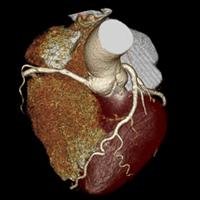
February 4, 2009 - In recent years, cardiac computed tomography angiography (CTA) has emerged as a useful diagnostic imaging modality for the assessment of coronary artery disease (CAD), and new research shows there are significantly lower doses of radiation associated with cardiac CTA than have been previously reported in several earlier studies.
The new study, the Prospective Multicenter Study On Radiation Dose Estimates Of Cardiac CT Angiography in Daily Practice I (PROTECTION I), published in this week’s Journal of the American Medical Association, confirms that it is entirely possible to significantly reduce the radiation dose in adequately selected patients. The study showed there is a wide degree of variability in radiation doses between sites.
The study, led by Dr. Jorg Hausleiter, Deutsches Herzzentrum München, Klinik an der Technischen Universität München in Munich, Germany, was observational and included 1,965 patients undergoing cardiac CTA between February and December 2007.
Researchers worldwide analyzed the results to identify independent predictors of radiation dose, measured as dose-length product (DLP). DLP is a reflection of the total amount of radiation deposited over the entire set of images during a patient’s CT. More familiar to most is the effective dose, measured in millisieverts (mSV), which was derived from the organ weighting factor for the chest. In PROTECTION I, the average dose was 12 mSV, which is notably lower than several earlier studies of cardiac CTA radiation doses.
PROTECTION I called attention to the varying degrees of radiation doses delivered between sites – specifically, the median DLP at the highest dose site was over six times that of the lowest dose site, and the remaining doses in between ran the gamut. Hausleiter and his colleagues identified several currently available key dose- reduction strategies which can be implemented in many more patients which would drive the average dose down even further: electrocardiographically controlled tube modulation (ECTCM), scan length, voltage and the use of sequential scanning. For example, with use of ECTCM, a 25 percent dose-reduction was achieved. The findings suggest that these dose-reduction methods can be used in the majority of patients, which should alert cardiac CT laboratories that they need to implement these strategies when performing cardiac CTA.
“Reducing the amount of radiation to the patient is something that is on the mind of virtually all physicians involved in cardiac CT,” said Daniel S. Berman, M.D. of Cedars-Sinai Medical Center and president of the Society of Cardiovascular Computed Tomography. “The amount of radiation now associated with cardiac CT is very similar to that of many other x-ray and nuclear medicine procedures. Coronary CT angiography is the most accurate noninvasive test for the detection of coronary artery disease. Given the low doses of radiation involved, when there is suspicion but not clear evidence that a patient has a blockage in a coronary artery needing evaluation, it is clearly safer to perform a coronary CT angiogram than to perform an invasive coronary angiogram.”
This study complements other recent studies of cardiac CTA that prove its excellent diagnostic accuracy compared to invasive angiography. Using the protocols identified in PROTECTION I, quality improvement measures should be developed to decrease the radiation potential in cardiac CTA. With lower radiation doses, the risk benefit equation shifts even more in favor of cardiac CTA as a first line diagnostic test for the evaluation of chest pain in appropriately selected patients.
The Society of Cardiovascular Computed Tomography (SCCT) is the recognized representative and advocate for physicians, scientists, and technologists who work in the field of cardiovascular computed tomography. With nearly 4000 members, SCCT is nationally and internationally viewed as the principal organization committed to the further development of cardiovascular computed tomography through research, education, quality and advocacy.
For more information: www.scct.org


 November 12, 2025
November 12, 2025 









